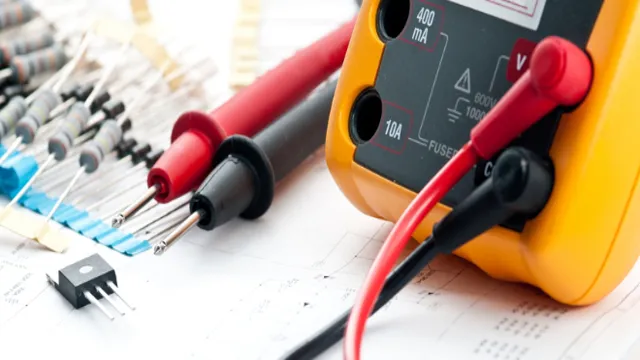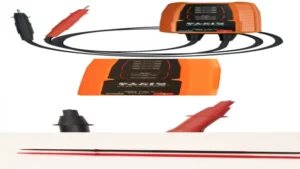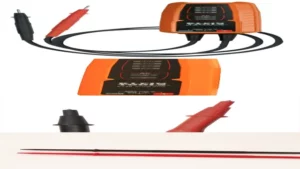Have you ever needed to work on electrical wires in your home but weren’t sure if they were live or not? Using a voltage tester can help keep you safe and prevent accidental electric shocks. It’s a simple tool that can make a big difference when working with electricity. Think of it like a metal detector, but for electricity.
Just like how a metal detector beeps when it detects metal, a voltage tester will light up or beep when it detects electricity in a wire. This allows you to double check that the power is off before you begin working on any wiring. Using a voltage tester correctly is important to ensure accurate readings.
It’s important to not only read the instructions carefully, but also to make sure you are using the correct type of tester for the job. There are non-contact voltage testers that don’t require direct contact with the wire, and there are contact voltage testers that require direct contact with the wire. Overall, using a voltage tester is a crucial step in ensuring your safety when working with wires.
Don’t forget to always double check before beginning any electrical work, and always use caution when working with electricity.
What is a Voltage Tester?
Yes, you can use a voltage tester on wires! A voltage tester is a handy tool that allows you to determine whether or not an electrical circuit is live. This is important for several reasons, including safety and avoiding damage to your equipment. With a voltage tester, you can easily test wires, outlets, and other electrical components to ensure that they are not carrying any electrical current before you begin working on them.
Simply hold the tester against the wire or outlet and the tool will indicate whether or not the circuit is live. It’s a simple yet invaluable tool that every DIY enthusiast or electrician should have in their toolbox. So if you’re thinking of doing any electrical work, don’t forget to grab your voltage tester first!
A device used to measure electrical potential difference
A voltage tester is a device used to measure the electrical potential difference in a circuit. It can be a useful tool for electricians, homeowners, or anyone working with electrical equipment. The main purpose of a voltage tester is to determine whether there is an electrical charge present in a circuit.
This is important because it can help prevent electrical shocks and ensure that electrical equipment is functioning properly. Voltage testers come in several different types, including non-contact testers, probe testers, and multimeters. Non-contact testers use a sensor to detect the presence of an electrical field without the need for physical contact with the circuit.
Probe testers, on the other hand, require physical contact with the circuit. Multimeters are more advanced voltage testers that can measure not only voltage but also current and resistance. Whether you are a professional electrician or just an amateur DIY-er, a voltage tester is an essential tool to have in your toolkit.
So, the next time you’re working with electrical equipment, make sure to use a voltage tester to ensure your safety and the proper functioning of your equipment.

Types of Voltage Testers
Yes, you can definitely use a voltage tester on wires, but you should know about the different types of voltage testers available to ensure you get the right one for the job. There are two main types of voltage testers that you’ll find: contact and non-contact. Contact voltage testers are used to detect current in a wire or device and require the tester’s probes to touch a conductive surface.
They can be digital or analog and are often used in electrical work as they provide a more accurate reading. Non-contact voltage testers, on the other hand, are used to detect voltage without making direct contact with the wire or device. These testers use electromagnetic fields to sense voltage and are often used by HVAC technicians or DIYers because they’re typically less expensive and easier to use than contact voltage testers.
Whether you choose contact or non-contact voltage testers, be sure to read their manuals and follow the instructions carefully to use them safely and effectively.
Non-contact, contact, and multi-meter testers
Voltage testers come in different types, including non-contact, contact, and multi-meter testers. Non-contact testers detect voltage without touching the electrical conductors. They use capacitive coupling, which makes them safer since technicians do not have to touch live wires.
Contact testers, on the other hand, require to touch the electrical conductors. They use a probe that directly connects to the circuit under test. They may require more skill and expertise than non-contact testers.
Lastly, multi-meter testers can measure voltage, resistance, and current, making them the most versatile testers. They come in both contact and non-contact types and are ideal for more technical applications. Whether you are an electrician, technician, or DIY enthusiast, there is a voltage tester suitable for your needs.
Always make sure to read through the specifications and instructions before using a voltage tester. Safety should always come first.
Precautions
Yes, you can absolutely use a voltage tester on wires, but it’s important to take the necessary precautions before doing so. First and foremost, make sure that the area you’re working in is dry and that you’re wearing insulated gloves and shoes. Additionally, turn off the power to the circuit you’re testing by flipping the circuit breaker or removing the fuse.
Once you’ve taken these safety measures, you can proceed with using the voltage tester to check for the presence of electrical current in the wires. Keep in mind that voltage testers come in different types, so make sure you’re using the appropriate one for your needs. Always follow the manufacturer’s instructions and proceed with caution to avoid injury or damage to yourself or your equipment.
As long as you take the necessary precautions and use the voltage tester correctly, you can safely test the electrical current in your wires.
Always ensure proper grounding and insulation of wires
Proper grounding and insulation of wires can prevent accidents and electrical shock. When dealing with electrical wiring, it’s essential to adhering to safety measures by ensuring that all wires are safely grounded and insulated. Always inspect wires before installing to ensure they’re in good condition and not worn out.
Also, check for any frayed wires, as they pose a crucial safety risk. When you’re wiring circuits, always avoid overloading them, and ensure that the circuit breakers are correctly sized. Furthermore, avoid using outdated wiring systems and sockets, and always choose high-quality products from reputable manufacturers.
When working with live electrical systems, it’s recommended to wear proper insulating gloves, clothing, and footwear to reduce the risk of electrical shock. Always keep in mind that one small mistake can be fatal, so be sure to follow all safety precautions and never take risks with electrical wiring. Remember, safety always comes first!
Wear rubber gloves when handling live wires
When working with live wires, it’s crucial to take the proper precautions to ensure your safety. One of the most important things you can do is wear rubber gloves when handling live wires. These gloves provide an extra layer of insulation between you and the current, reducing your risk of electric shock.
However, it’s important to remember that rubber gloves are not a substitute for proper training and safety procedures. Always ensure that you know what you’re doing before handling any electrical equipment, and never attempt any repairs or installations unless you are properly trained and equipped to do so. By taking the necessary precautions and using the proper safety equipment, you can keep yourself safe while working with live wires.
Stay safe and stay protected!
How to Use a Voltage Tester on Wires
Yes, you can use a voltage tester on wires. A voltage tester is a useful tool that can help you determine if electrical wires are live or not. This tool works by detecting the electrical field that surrounds a charged wire.
To use a voltage tester on wires, you first need to turn off the power supply to the circuit you will be working on. Then, touch the probes of the voltage tester to the wires you want to check. If the tester lights up or makes a noise, this indicates that the wires are live and should not be touched.
It is important to use a high-quality voltage tester and wear protective gear, such as gloves and goggles, when working with electricity. By using a voltage tester on wires, you can help to ensure your safety and prevent electrical accidents.
Turn off power to the circuit being tested
When using a voltage tester on wires, it is critical to turn off the power to the circuit being tested. This step is essential to ensure your safety as working with live electrical wires can lead to electric shock or even death. It only takes a moment to flip the circuit breaker or pull the fuse, which can make a significant difference in your safety.
Once you confirm that the power to the circuit is off, you may proceed with using the voltage tester. Start by selecting the appropriate voltage range, which is usually marked on the tool or in its user manual. Next, touch the tester’s metal tip to the wire’s insulation and hold it steady.
If the tester emits a beep or a light turns on, it means that the wire is live, and the power to the circuit needs to be turned off before proceeding with any repairs. Remember to keep the voltage tester away from your face, body, and any conductive material to prevent accidental contact with live wires. By following these steps, you can use a voltage tester on wires safely and effectively.
Insert tester into the wire or touch it to the exposed wire
Using a voltage tester on wires is a simple and efficient way to ensure your electrical connections are safe. First, locate the wire you want to test and turn off the power supply. Then, gently insert the tester into the wire or touch it to the exposed wire.
The tester will indicate whether the wire is live or not by light or sound. If the wire is live, it’s important to take necessary precautions before continuing work. Remember to make sure your hands are dry and never touch any bare wires that may be hot.
Always use a voltage tester to confirm if a wire is safe to handle before conducting any work, as this will minimize the risk of electrical shock or fire. By taking the time to properly test your wires, you can work with greater confidence and ensure electrical safety in your home or workplace.
Read the voltage measurement on the tester’s display
When it comes to working with wires, safety is key. That’s where a voltage tester comes in handy! To use a voltage tester on wires, start by turning off the power to the circuit you’ll be working on. Then, select the appropriate tester for the job and make sure that it’s working properly.
Hold the tester’s probe against the exposed wire or against the insulation, depending on the type of tester you’re using. Be sure to maintain a good grip on the tester and to keep your fingers away from the metal probes. Once the tester is in place, turn the power back on.
If the tester beeps or lights up, that means electricity is present. Read the voltage measurement on the tester’s display to determine how strong the current is. Remember to always use caution when working with electricity and consult a professional if you’re unsure about what you’re doing.
Stay safe out there!
Conclusion
In conclusion, can you use a voltage tester on wires? Of course you can! It’s like a modern-day divining rod, leading you to the source of electrical power. But just like a divining rod, it’s important to handle it with care and proper knowledge. So, Voltage Tester on, my fellow electrical adventurers, and may your discoveries always be electrifying (in a good way, of course).
“
FAQs
What is a voltage tester and how does it work?
A voltage tester is a tool used to test the presence and strength of electrical voltage in a circuit. It works by detecting the electrical fields produced by live wires or components and producing a visual or audible signal.
Are voltage testers safe to use?
Yes, voltage testers are safe to use when used correctly. It is important to follow the instructions provided with the tool and take appropriate safety precautions such as wearing safety gloves and avoiding contact with live wires.
Can a voltage tester be used on both AC and DC circuits?
It depends on the type of voltage tester. Some testers are designed specifically for AC circuits, while others can be used for both AC and DC circuits. It is important to check the specifications of the tester to ensure it is appropriate for the circuit being tested.
How do I use a voltage tester on wires?
To use a voltage tester on wires, first ensure that the circuit is turned off. Then, touch the probes of the tester to the exposed wires or terminals and observe the reading on the tester. If the tester indicates the presence of electrical voltage, do not touch the wires and seek professional assistance.
Can a voltage tester be used to test the voltage of batteries?
Yes, a voltage tester can be used to test the voltage of batteries. Simply touch the probes of the tester to the positive and negative terminals of the battery and observe the reading on the tester.
What is the difference between a digital and analog voltage tester?
A digital voltage tester provides a numerical readout of the voltage being measured, while an analog voltage tester uses a needle or pointer to indicate the presence and strength of voltage. Both types of testers are effective and it is largely a matter of personal preference which type to use.
Can a voltage tester be used to test the voltage of electrical outlets?
Yes, a voltage tester can be used to test the voltage of electrical outlets. Simply touch the probes of the tester to the holes in the outlet and observe the reading on the tester. If the tester indicates the presence of electrical voltage, do not touch the outlet and seek professional assistance.






